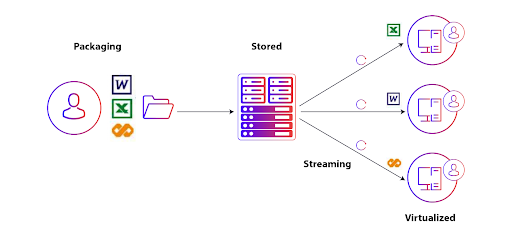Introduction
In the fast-paced realm of technology, businesses are constantly seeking innovative solutions to enhance their operations and stay ahead of the competition. One such transformative technology that has gained prominence is Network Virtualization. This article delves into the myriad benefits of network virtualization and provides insights into its seamless implementation.
Understanding Network Virtualization
What is Network Virtualization?
Network virtualization is a revolutionary technology that involves creating multiple virtual networks within a single physical network infrastructure. It enables the abstraction of network resources from the underlying hardware, allowing for greater flexibility, scalability, and efficiency in network management.
Key Components of Network Virtualization
- Hypervisor: At the core of network virtualization is the hypervisor, a software layer that abstracts physical network hardware and enables the creation and management of virtual networks. It plays a crucial role in allocating resources, managing traffic, and ensuring the seamless operation of virtualized networks.
- Virtual Switches: Virtual switches act as the traffic controllers within a virtualized network. They facilitate communication between virtual machines (VMs) and external networks, directing data packets efficiently and ensuring secure and optimized data flow.
- Network Overlays: Network overlays create virtualized networks on top of the existing physical infrastructure. These overlays enable the segmentation of network traffic, allowing different virtual networks to operate independently and securely within the same physical network.
- Software-Defined Networking (SDN): SDN is a key enabler of network virtualization, providing a centralized and programmable approach to network management. It separates the control plane from the data plane, allowing for dynamic and automated configuration of network devices.
Benefits of Network Virtualization
- Resource Optimization: Network virtualization allows for the efficient allocation of resources based on demand. This results in optimal utilization of hardware resources, reducing costs associated with over-provisioning and underutilization.
- Flexibility and Scalability: Virtualized networks offer unprecedented flexibility, enabling businesses to adapt quickly to changing requirements. Scaling resources up or down becomes a seamless process, promoting agility in response to evolving business needs.
- Improved Network Management: The centralization of network management through virtualization simplifies administration tasks. Administrators gain enhanced visibility and control over the entire network, leading to more effective monitoring, troubleshooting, and configuration management.
- Enhanced Security: Network virtualization enhances security by providing isolation between virtual networks. This segmentation ensures that a security breach in one virtual network does not compromise the integrity of others, bolstering overall network security.
Real-world Applications of Network Virtualization
- Data Center Optimization: Virtualizing networks in data centers enables efficient resource utilization, rapid provisioning of services, and seamless migration of virtual machines.
- Multi-Tenancy Support: Network virtualization facilitates multi-tenancy, allowing businesses to share the same physical infrastructure while maintaining isolated and secure virtual networks for different users or departments.
- Cloud Computing Integration: Cloud services leverage network virtualization to create dynamic, scalable, and on-demand network infrastructures, providing businesses with the flexibility to adapt to changing workloads.

Key Benefits of Network Virtualization
Network virtualization is a powerful technology that offers a range of benefits to businesses seeking to optimize their network infrastructure.
- Cost Efficiency: Network virtualization enables organizations to reduce capital and operational expenses significantly. By decoupling network functions from physical hardware, businesses can optimize resource utilization, minimize the need for extensive infrastructure, and scale their networks efficiently.
- Enhanced Flexibility and Scalability: Virtualized networks provide unparalleled flexibility, allowing businesses to adapt quickly to changing requirements. The ability to dynamically allocate and scale resources ensures that the network can easily accommodate increased workloads without the need for extensive hardware upgrades.
- Resource Optimization: Virtualization allows for the efficient use of network resources. By abstracting network functions, businesses can allocate resources based on demand, preventing over-provisioning and ensuring optimal utilization of hardware resources.
- Improved Network Management: Network virtualization centralizes network management, providing administrators with a unified and simplified interface. This streamlined approach enhances visibility, control, and troubleshooting capabilities, reducing the complexity associated with traditional network setups.
- Rapid Provisioning of Services: Virtualized networks enable quick and automated provisioning of services. This agility is particularly beneficial in dynamic business environments where the rapid deployment of new services and applications is essential.
- Isolation and Security: Network virtualization enhances security by isolating virtual networks from each other. This isolation ensures that potential security breaches in one virtual network do not impact others, providing an added layer of protection and minimizing the risk of lateral movement in the event of a security incident.
- Adaptability to Changing Workloads: Virtualized networks are inherently adaptable, allowing organizations to scale resources up or down based on changing workloads. This adaptability is crucial in modern business environments where demand for network resources can fluctuate rapidly.
- Improved Disaster Recovery: Virtualization facilitates more efficient disaster recovery processes. Virtual machines and networks can be replicated and easily moved to different physical locations, ensuring business continuity in the event of a disaster or system failure.
- Support for Multi-Tenancy: Network virtualization supports multi-tenancy, allowing multiple virtual networks to coexist on the same physical infrastructure. This is particularly valuable for service providers and organizations that need to provide isolated network environments for different users or departments.
- Streamlined Software Updates and Maintenance: Virtualization simplifies software updates and maintenance tasks. Administrators can implement changes and updates more efficiently without disrupting the entire network, leading to improved overall network reliability.
In conclusion, network virtualization offers a myriad of benefits, from cost savings and improved flexibility to enhanced security and streamlined management. Embracing this technology can empower businesses to build more agile, efficient, and resilient network infrastructures to meet the demands of the digital age.
Implementing Network Virtualization
As businesses evolve in the digital age, the adoption of innovative technologies becomes imperative for staying competitive. Network virtualization stands out as a transformative solution, providing organizations with the agility, scalability, and efficiency needed in today’s dynamic business landscape. This article serves as a comprehensive guide for implementing network virtualization, exploring the key steps and considerations for a successful integration.
Assessing Current Infrastructure
- Conduct a Comprehensive Network Assessment: Begin by analyzing your existing network infrastructure. Identify bottlenecks, areas of inefficiency, and potential points of improvement. This assessment serves as the foundation for determining where network virtualization can deliver the most significant impact.
- Evaluate Hardware Compatibility: Ensure that your current hardware is compatible with network virtualization requirements. While virtualization is designed to be flexible, a thorough evaluation helps identify any potential limitations or the need for hardware upgrades.
Choosing the Right Virtualization Platform
- Understand Your Business Needs: Define your organization’s specific requirements and goals. Different virtualization platforms, such as Software-Defined Networking (SDN) and Network Function Virtualization (NFV), cater to distinct needs. Choose a platform aligned with your business objectives.
- Evaluate Vendor Solutions: Research and evaluate various virtualization solutions from reputable vendors. Consider factors such as scalability, security features, integration capabilities, and ongoing support. Opt for a solution that aligns with your organization’s long-term vision.
Integration and Deployment
- Create a Detailed Implementation Plan: Develop a comprehensive plan outlining the stages of integration. Define roles and responsibilities within your IT team, establish timelines, and allocate resources effectively.
- Implement in Phases: To minimize disruption, deploy network virtualization in phases. Begin with non-critical areas to test and refine the implementation before moving to more mission-critical components. This approach allows for smoother transitions and faster issue resolution.
- Integrate with Existing Systems: Ensure seamless integration with existing systems, applications, and services. This includes compatibility with cloud services, databases, and other critical components of your IT ecosystem.
Staff Training and Skill Development
- Train IT Teams: Equip your IT teams with the necessary skills to manage and troubleshoot virtualized networks. Provide training on the chosen virtualization platform, emphasizing best practices and efficient network management.
- Encourage Certification: Encourage IT professionals to pursue relevant certifications in network virtualization. Certifications validate expertise and ensure that your team stays abreast of the latest developments and best practices in the field.
Continuous Monitoring and Optimization
- Implement Monitoring Tools: Utilize network monitoring tools to keep a close eye on performance, security, and resource utilization. Proactive monitoring allows for early detection of issues and timely resolution.
- Optimize Configuration: Regularly review and optimize network configurations based on evolving business needs. Adjust resource allocations, security settings, and other parameters to ensure continued efficiency.
Conclusion
Implementing network virtualization is a strategic move that can revolutionize your organization’s network infrastructure. By following a structured approach, businesses can smoothly integrate virtualization solutions, unlocking the full potential of enhanced efficiency, flexibility, and scalability. Embrace the future of networking with network virtualization and position your organization for sustained success in the digital era.
Unleashing Innovation of Network Virtulization
In the ever-evolving landscape of technology, businesses are constantly seeking ways to innovate and deliver services more efficiently. Network virtualization emerges not only as a transformative tool for optimizing infrastructure but also as a catalyst for unleashing innovation within organizations. This article explores a unique aspect of network virtualization – its role in fostering innovation and enhancing service delivery.
Empowering Innovation through Network Virtualization
- Dynamic Service Provisioning: Network virtualization enables dynamic and on-demand service provisioning. This capability allows businesses to experiment with new services and applications without the constraints of traditional infrastructure limitations. Teams can rapidly deploy, test, and iterate on innovative solutions, fostering a culture of continuous improvement and adaptation.
Realizing Benefits through Innovative Practices
- Rapid Service Deployment: With network virtualization, businesses can swiftly deploy new services and applications in response to changing market demands. The agility provided by virtualized networks ensures that innovative ideas can be implemented quickly, giving organizations a competitive edge in delivering cutting-edge solutions to their customers.
- Facilitating DevOps Practices: Network virtualization aligns seamlessly with DevOps practices, fostering collaboration between development and operations teams. This collaboration accelerates the development and deployment of innovative services, as virtualized environments allow for more efficient testing, integration, and delivery of applications.
Case Study: Accelerating Innovation with Network Virtualization
- Agile Development at Scale: A leading technology company implemented network virtualization to support its agile development practices. By creating virtualized environments for testing and development, the company reduced the time it took to bring new features to market. This accelerated pace of innovation allowed the organization to stay ahead of industry trends and meet customer expectations.
Best Practices for Harnessing Innovation with Network Virtualization
- Encourage Cross-Functional Collaboration: Foster collaboration between network administrators, developers, and other stakeholders to encourage the exchange of innovative ideas. Cross-functional teams can work together to leverage the flexibility of virtualized networks for creative problem-solving and service delivery.
- Invest in Training and Skill Development: Provide ongoing training for teams to harness the full potential of network virtualization for innovation. Ensuring that staff is well-versed in the latest virtualization technologies enables them to explore new possibilities and implement innovative solutions effectively.



